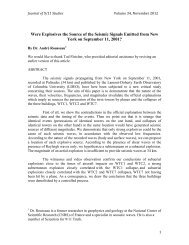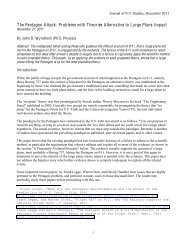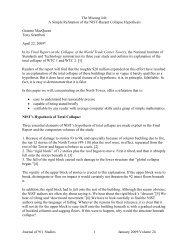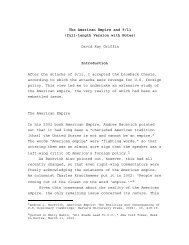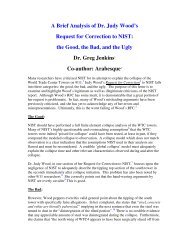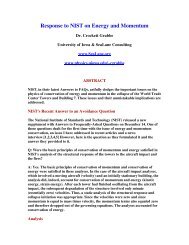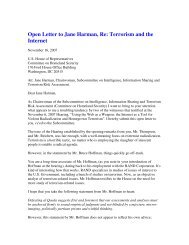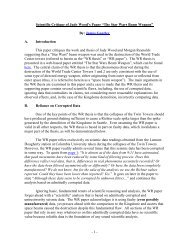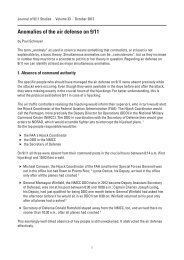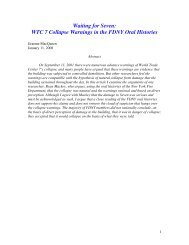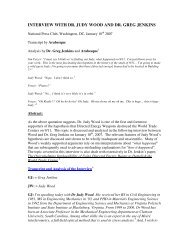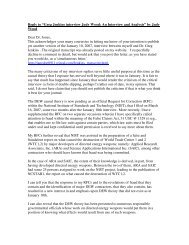David Chandler Responds to Frank Greening - Journal of 9/11 Studies
David Chandler Responds to Frank Greening - Journal of 9/11 Studies
David Chandler Responds to Frank Greening - Journal of 9/11 Studies
You also want an ePaper? Increase the reach of your titles
YUMPU automatically turns print PDFs into web optimized ePapers that Google loves.
that the upper block remains intact. The significant thing, as I’ve shown, is that the force <strong>of</strong><br />
resistance is significantly less than the weight <strong>of</strong> the falling block. If you assume the upper<br />
block is accreting mass, as you have challenged me <strong>to</strong> consider, even the statement that the<br />
resisting force is constant is no longer true.<br />
FG, in a lengthy paragraph, shortened here:<br />
When I say that E1 is “the energy <strong>to</strong> collapse one floor” please note that E1 includes all the<br />
energy consumed during the descent <strong>of</strong> the upper block through one floor height (~ 3.7<br />
meters). Etc. …. Thus we see that E1/M is indeed approximately constant for the floors <strong>of</strong><br />
interest.<br />
Response:<br />
You are using circular reasoning. You are not dealing with the reality. You are dealing with<br />
consequences <strong>of</strong> your simplifying assumptions. More <strong>to</strong> the point, none <strong>of</strong> this is relevant <strong>to</strong><br />
the issue at hand. I have laid out a clear, coherent argument that the falling block could not<br />
deliver the force needed <strong>to</strong> crush the bot<strong>to</strong>m section <strong>of</strong> the building while it continued <strong>to</strong><br />
accelerate downward. None <strong>of</strong> what you say in the previous paragraph or the remainder <strong>of</strong><br />
your letter even addresses this issue.<br />
FG:<br />
On the question <strong>of</strong> energy transfer, deceleration and all that, I would say…etc.<br />
Response:<br />
What on earth do you mean by “energy transfer, deceleration, and all that…”? Many <strong>of</strong> the<br />
fragments in this paragraph are true enough, but they don’t go anywhere. They don’t advance<br />
your argument. They don’t challenge mine. They are not illuminating. There’s nothing here<br />
<strong>to</strong> respond <strong>to</strong>.<br />
FG:<br />
The collapse <strong>of</strong> WTC 1 is best studied by considering how potential energy was converted <strong>to</strong><br />
kinetic energy and dissipated at the crush front and subsequently within the steadily growing<br />
debris/rubble layer. This debris layer was not only a sink for potential energy, but a source <strong>of</strong><br />
random fluctuations in the motions <strong>of</strong> the individual debris particles. These fluctuations<br />
cannot exert a net resultant force against the downward motion <strong>of</strong> the upper block but rather<br />
serve <strong>to</strong> control the gravitational work rate. In fact, if this type <strong>of</strong> collapse should attain a state<br />
<strong>of</strong> dynamic equilibrium, there will be a balance between the production <strong>of</strong> fluctuation energy<br />
at the crush front and the conversion <strong>of</strong> this energy <strong>to</strong> heat within the debris layer through the<br />
dissipating effects <strong>of</strong> many random collisions <strong>of</strong> debris particles. It is considerations such as<br />
these that help <strong>to</strong> quantify the complexities <strong>of</strong> the WTC 1 collapse, not naïve applications <strong>of</strong><br />
New<strong>to</strong>n’s 3 rd Law <strong>of</strong> motion.<br />
Response:<br />
You are engaging in pseudo academic obfuscation. In my video I have made the argument<br />
that the constant acceleration <strong>of</strong> the <strong>to</strong>p section <strong>of</strong> the building implies that the resistive force<br />
is much less than the weight <strong>of</strong> the falling block. If I’m wrong, show me how. You seem <strong>to</strong><br />
be hoping non-technical readers will assume what you have said is pr<strong>of</strong>ound. It is not<br />
pr<strong>of</strong>ound. It is incoherent.<br />
Unsuspecting readers may not understand the significance <strong>of</strong> your last line. They should be<br />
informed that the reason you view the application <strong>of</strong> New<strong>to</strong>n’s 3 rd Law <strong>of</strong> motion as naïve, is<br />
because, as you have clearly and repeatedly stated in both private correspondence and public<br />
forums, that you believe New<strong>to</strong>n’s 3 rd Law does not apply <strong>to</strong> falling buildings. That, <strong>of</strong><br />
course, is utter nonsense. Your entire letter needs <strong>to</strong> be read and unders<strong>to</strong>od in the light <strong>of</strong><br />
this concluding statement. Your argument is not with me; it is with Isaac New<strong>to</strong>n.<br />
3



